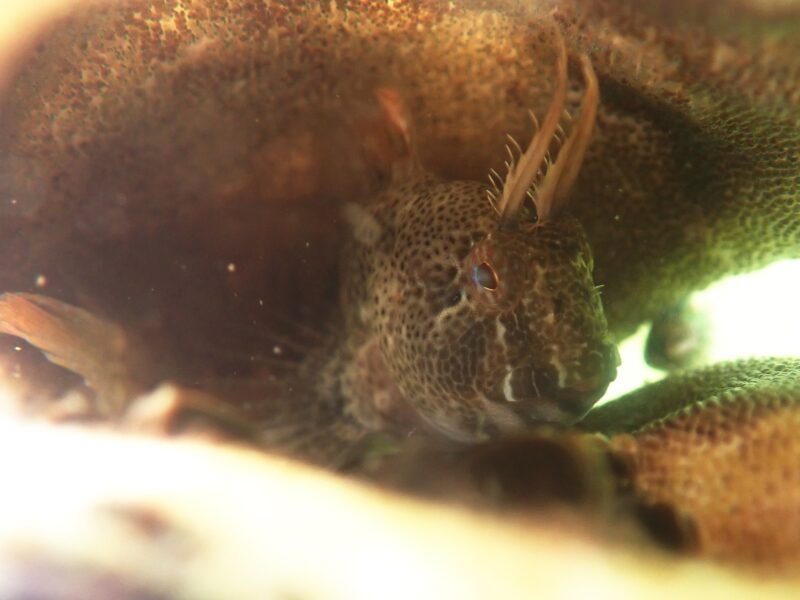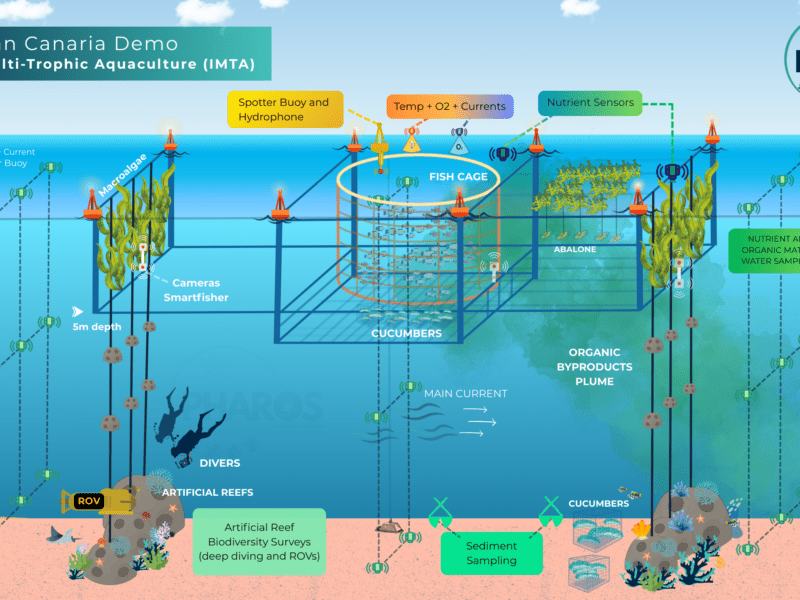
Four Solutions Aim to Restore Marine Life by 2030
Four Solutions Aim to Restore Marine Life by 2030 https://pharosproject.eu/wp-content/uploads/2024/10/GYY36u-WQAASPut-2-1024x768.jpeg 1024 768 PHAROS Project PHAROS Project https://pharosproject.eu/wp-content/uploads/2024/10/GYY36u-WQAASPut-2-1024x768.jpegThe world’s oceans are in crisis, but an ambitious European Union project is providing innovative solutions that could help restore marine life.
The PHAROS project, funded through the EU’s Horizon programme, represents a new frontier in combining aquaculture, artificial intelligence, and nature-based solutions to heal damaged seas.
Running from September 2024 through August 2029, PHAROS, which stands for Nature-Based Solutions and Sustainable Blue Economies for Ocean Restoration, has deployed four demonstration projects across the Atlantic and Arctic regions.
These aren’t just research experiments, they’re practical blueprints for how humanity can work with nature rather than against it to restore marine biodiversity while creating sustainable economic opportunities.
Oceans Under Pressure & How To Restore Marine Life
Marine ecosystems face unprecedented threats from climate change, overfishing, pollution, and habitat destruction. Natural coral reefs and underwater habitats have been severely damaged by human activities, leading to biodiversity loss that threatens both marine life and the millions of people who depend on healthy oceans for their livelihoods.
Nearly 20% of Europe’s endangered species face extinction due to factors including invasive organisms, a figure expected to rise in coming years.
The economic stakes are enormous. The ocean contributes approximately $3 trillion annually to the global economy, yet mismanagement causes nearly $1 trillion in losses each year. Europe’s “Restore Our Ocean and Waters by 2030” mission recognizes that protecting marine ecosystems isn’t just an environmental imperative, it’s an economic opportunity that could generate up to 32 million new jobs by 2030 while enhancing food security and coastal resilience.
Solution One: The Ocean Farm of the Future in Gran Canaria
Off the coast of Gran Canaria in the Canary Islands, scientists are testing what might be the future of sustainable seafood production. The first PHAROS demonstration site combines traditional fish farming with an ingenious ecosystem approach called Integrated Multi-Trophic Aquaculture, or IMTA.
The concept is elegantly simple yet revolutionary: create an underwater farm where different species work together like a natural ecosystem. At the center sit standard fish cages raising commercial finfish. But rather than allowing fish waste, nitrogen, phosphorus, and organic matter, to pollute surrounding waters, the system captures these nutrients and converts them into valuable products.
Surrounding the fish cages, macroalgae (seaweed) grow on vertical lines, acting as natural water filters by absorbing excess nutrients while simultaneously sequestering carbon dioxide. Below the fish cages, sea cucumbers in specialized mesh units consume organic waste particles that settle to the seafloor, preventing sediment pollution.
The system also includes experimental abalone farming, with these valuable shellfish feeding on the cultivated seaweed, creating a closed-loop food web.
IMTA works by creating a closed-loop system where the by-products such as excess nutrients and organic waste from fish farming are utilized by other species such as shellfish and seaweed. This process can decrease water pollution, minimize the need for chemical fertilizers, and improve overall ecosystem health.
The environmental benefits extend beyond waste management. The macroalgae forests create three-dimensional habitats throughout the water column, providing shelter and breeding grounds for wild fish and marine invertebrates. This approach could help revitalize waters near the Canary Islands that have become nearly “oligotrophic desert” status due to severe anthropogenic disturbance.
Solution Two: Artificial Reefs That “Think“
Also in Gran Canaria, PHAROS researchers are deploying Smart Enhanced Reefs®, custom-designed artificial reef structures that go far beyond simply dropping concrete blocks into the ocean.
These high-tech reefs are engineered using sophisticated design software to create optimal habitats for specific marine species. Made from inert materials resembling natural rock, the structures are fabricated using advanced techniques like 3D printing to create complex surfaces and crevices that attract fish, crustaceans, mollusks, and other marine life.
What makes them “smart” is the extensive monitoring technology integrated into the system. Underwater cameras equipped with artificial intelligence automatically identify and count fish species. Hydrophones record underwater soundscapes, detecting marine mammals and assessing the impact of human noise pollution. Environmental sensors continuously measure water quality, temperature, salinity, and nutrient levels. All this data feeds into a Digital Twin of the Ocean, a virtual model that helps scientists understand ecosystem dynamics in real-time.
The reefs serve multiple purposes: they provide habitat for endangered species, create nursery areas for juvenile fish, help stabilize sediments, and even protect coastlines from erosion by breaking wave energy. By combining these artificial structures with macroalgae cultivation, the project creates “marine forests” that support biodiversity while capturing atmospheric carbon.
Artificial reefs have proven remarkably effective at attracting marine life. Studies show they can enhance biodiversity, support commercially valuable fish species, and serve as “living laboratories” for researchers studying marine ecosystems.
The PHAROS approach takes this further by carefully monitoring which species colonize the reefs and how the ecosystem develops over time, providing crucial data for scaling up restoration efforts.
Solution Three: Seaweed Farms in Irish Waters
Along Ireland’s Atlantic coast, the third PHAROS demonstration tests whether large-scale seaweed cultivation can coexist with, and even benefit, traditional salmon farming.
At sites in Bantry Bay and Roaringwater Bay, researchers are growing three species of kelp: Alaria esculenta (badderlocks), Saccharina latissima (sugar kelp), and Laminaria digitata (oarweed). These fast-growing macroalgae are cultivated on 110-meter longlines suspended in the water, with the Bantry Bay site positioned downstream from a salmon farm to test whether the seaweed can absorb excess nutrients from fish production.
The potential benefits are substantial. Macroalgae are among nature’s most efficient carbon capture systems, absorbing dissolved CO₂ through photosynthesis at rates that could make significant contributions to climate change mitigation.
One study suggested that seaweed farms covering just 9% of the ocean could produce enough biomethane to supply Earth’s fossil fuel energy demand while removing 53 billion tonnes of CO₂ annually.
Beyond carbon sequestration, the seaweed farms create complex three-dimensional habitats that support marine biodiversity. The structures provide shelter for juvenile fish, crustaceans, and invertebrates while improving water quality by absorbing excess nitrogen and phosphorus that can cause harmful algal blooms. This “polyculture” approach, growing multiple species together, enhances ecosystem resilience and provides economic diversification for coastal communities.
The Irish demonstration will run trials over multiple growing seasons, carefully monitoring biodiversity changes, nutrient uptake, and the seaweed’s performance in both IMTA settings and standalone cultivation.
Monthly sampling campaigns track growth rates, species composition of associated marine life, and water quality parameters to assess the full environmental impact.
Solution Four: Hunting Invasive Salmon with DNA
In Iceland’s northern fjords, PHAROS is deploying cutting-edge genetic technology to combat an unexpected threat: invasive pink salmon that endanger native fish populations.
Pink salmon, native to Alaska and Canada, were artificially introduced to the Atlantic by the Soviet Union in 1956. With their high reproductive rates and ability to adapt to non-native habitats, these fish have spread rapidly through Arctic and European waters, competing with indigenous Atlantic salmon, Arctic char, and brown trout while introducing diseases and parasites.
The PHAROS solution involves an Environmental Sample Processor, essentially a robotic DNA detective that automatically collects water samples, filters them, and analyzes the genetic material floating in the water (called environmental DNA or eDNA).
This technology can detect the presence of specific fish species in real-time, providing early warning when invasive pink salmon begin their spawning migration into Icelandic rivers.
“Environmental DNA testing allows for high sensitivity monitoring efforts of cryptic species in large, remote systems,” explain researchers working with this technology.
The approach is far more efficient than traditional visual surveys or fish trapping, and it can detect species even when populations are very small, exactly when eradication efforts have the best chance of success.
The system monitors not just pink salmon but also native species like Atlantic salmon, brown trout, Arctic char, and European flounder, providing comprehensive data on fish community composition.
Underwater cameras and hydrophones complement the eDNA sampling, even detecting seal populations that follow pink salmon into estuaries.
Once invasive salmon are detected, targeted removal measures swing into action: electrofishing, specialized nets, and traps designed to catch pink salmon while minimizing harm to native species. The goal is ambitious, reducing invasive populations by more than 50% to protect Iceland’s valuable native fish stocks.
The Technology Behind the Science
What sets PHAROS apart from previous restoration efforts is its integration of advanced monitoring technologies and digital modeling. The project employs:
- Artificial Intelligence and Machine Learning: Underwater cameras use pre-trained AI models to automatically identify fish species, estimate biomass, count individuals, and analyze behavioral patterns. This allows continuous, non-intrusive monitoring of marine life
- Advanced Acoustic Monitoring: Sophisticated hydrophone systems like SCOUT-S and SCOUT-C record underwater soundscapes, using AI to detect and classify marine mammals, vessels, and other sound sources. The data feeds into high-fidelity noise propagation models that assess how human activities impact marine environments.
- Oceanographic Modeling: High-resolution computer models simulate wave patterns, currents, temperature, and nutrient dispersal, helping scientists predict how ecosystems will respond to different interventions. These models continuously refine themselves based on real-time sensor data.
- Digital Twin of the Ocean: All monitoring data flows into integrated digital platforms that create virtual replicas of the marine environments. These “digital twins” allow researchers to test scenarios, forecast ecosystem changes, and provide decision-support tools for scaling solutions to other locations.
From Demonstration to Transformation
The four PHAROS demonstrations are explicitly designed to be replicable. Each site serves as a proof-of-concept that can be adapted to different marine environments across Europe and beyond.
The economic model is crucial to this vision. Demo 1 will generate multiple commercial products: fish, seaweed, sea cucumbers, and abalone, all while improving ecosystem health. Demo 3’s seaweed harvest will be partially sold to recover costs and demonstrate commercial viability. This approach shows that ocean restoration doesn’t have to be charity; it can be profitable while healing damaged ecosystems.
The projects also emphasize community engagement through “Living Labs”, collaborative spaces where local stakeholders, fishermen, entrepreneurs, and citizens participate in restoration initiatives.
This participatory approach ensures that solutions are culturally appropriate, economically viable, and supported by the communities who will ultimately implement them at scale.
“We are not merely setting environmental targets; we are unlocking economic opportunities,” emphasized Kęstutis Sadauskas, Deputy Director-General of the European Commission’s Directorate-General for Maritime Affairs and Fisheries, noting that nearly half a billion euros has been channeled into ocean innovation projects across 220 pilot sites.
The Path to 2030
The PHAROS project aligns with the EU Ocean Mission’s ambitious targets: protect and restore marine ecosystems, prevent and eliminate ocean pollution, and create a sustainable, carbon-neutral, circular blue economy by 2030.
The scale of the challenge demands urgency. With over 70% of updated national climate commitments now incorporating ocean-based measures, and the blue economy contributing 5% of global GDP while employing hundreds of millions of people, the stakes couldn’t be higher.
Nature-based solutions like those implemented by PHAROS offer hope. Rather than fighting against natural processes, these approaches work with ocean ecosystems, restoring habitats, enhancing biodiversity, sequestering carbon, and creating sustainable livelihoods simultaneously.
The four demonstrations will run through 2029, with regular monitoring, adaptive management, and progressive scaling of successful approaches. Key milestones include deployment of all infrastructure by 2025-2026, multiple growth and monitoring cycles through 2027-2028, and comprehensive assessment and replication planning by 2029.
If successful, PHAROS could provide the blueprint for a transformed relationship between humanity and the ocean and restore marine life.
From the artificial reefs of Gran Canaria to the seaweed farms of Ireland and the DNA detectives of Iceland, these innovations represent more than scientific experiments. They’re practical demonstrations that another future is possible: one where thriving oceans support thriving communities, and where nature’s recovery becomes the foundation for sustainable prosperity.
Sources
- https://www.marinebio.org/conservation/artificial-reefs/
- https://networknature.eu/networknature/article/nature-based-solutions-help-safeguard-marine-biodiversity-future-climate
- https://www.decadeonrestoration.org/nature-based-solutions-can-generate-32-million-new-jobs-2030-investments-skills-needed
- https://www.undp.org/press-releases/ocean-and-blue-economy-are-fundamental-addressing-triple-planetary-crisis-says-undp
- https://pharosproject.eu/blog/blue-economy-blueprint/
- https://aquadapt.org/2024/05/16/imta-sustainable-system/
- https://theoceanmovement.org/artificial-reefs/
- https://pubmed.ncbi.nlm.nih.gov/39644633/
- https://spj.science.org/doi/10.34133/olar.0033
- https://www.frontiersin.org/journals/marine-science/articles/10.3389/fmars.2020.00156/full
- Posted In:
- BLOG
- Marine Restoration

